
San Francisco Juvenile Probation
Department Monthly Statistics
Through June 2024

SanFranciscoJuvenileProbationDepartment
MonthlyDataReport
• The Juvenile Probation Department is engaged in efforts to generate more comprehensive,
accurate, and meaningful metrics.
• This report compiles data through the month before last (June 2024).
• A recent daily snapshot of the Juvenile Hall population will be included for the Commission meeting.
• Starting on page 5, each chart slide is preceded by a definition/methodology slide explaining the
chart's content.
• Time periods range depending on data availability and are noted on each chart.
• An Executive Summary for the month has been added to slide 3, with headings that hyperlink to
relevant graphs in the report.
2

SanFranciscoJuvenileProbationDepartment
Executiv e Summary‐ June
• Referrals: There were 75 referrals, 11% lower than the 2023 average of 84 referrals a month. 18 of the referrals were
for 707(b) offenses (24%).
• Admissions: There were 38 admissions, 27% higher than the 2023 average of 30 admissions a month.
• Population: The average daily population was 28 youth, 8% higher than the 2023 average of 26 youth. The peak
population was 25 youth.
• Length of Stay: The median LOS for releases was 7 days, longer than the 2023 average of 6 days.
• Caseload: There were 389 youth on active caseload, 3% higher than the 2023 average of 379 youth on active caseload
a month.
• Diversion: 38% of pre-adjudicated cases were being handled through various types of diversion.
• Programs: 75% of youth on active caseload were active in programs, 5 percentage points higher than the 2023 average
of 70%.
• Placements: There were 48 youth in alternative placements, 60% higher than the 2023 average of 30 youth.
• Warrants: There were 42 youth with active warrants as of the last day of the month, 20% higher than the 2023 average
of 35 youth.
3

SanFranciscoJuvenileProbationDepartment
JuvenileHallSnapshot:8/11/2024(N=21)
Notes: SYTF = Secure Youth Treatment Facility; JH = Juvenile Hall
4

SanFranciscoJuvenileProbationDepartment
JHCharts1.1&1.2:Admissions,Releases,&Population
• Description
• Chart 1.1 displays Juvenile Hall admissions and releases by calendar month.
• Chart 1.2 displays the average daily population (ADP) by month - the average number of youth
in custody per day for each month, & the peak population by month - the highest population
count reached each month.
• In June,
• There were 38 admissions and 28 releases.
• The ADP was 28 youth and the peak population was 37 youth.
5

SanFranciscoJuvenileProbationDepartment
JH1.1:Admissions&Releases
6

SanFranciscoJuvenileProbationDepartment
JH1.2:Average&PeakPopulat ion
7

SanFranciscoJuvenileProbationDepartment
JHCharts2.1‐ 2.4:ADPbyDetails
• Description
• Charts in this section display Average Daily Population (ADP) of youth in Juvenile Hall by
gender (2.1), race/ethnicity (2.2), age (2.3), and status (2.4).
• Note: Due to rounding errors, ADP by demographics may differ from overall ADP.
• In June,
• The gender breakdown of the ADP in Juvenile Hall was 4% girls and 96% boys.
• The racial/ethnic breakdown of the ADP in Juvenile Hall was 56% Black youth, 44% Latinx
youth, and 4% AAPI youth.
• The age breakdown of the ADP in Juvenile Hall was 33% young adults ages 18 and older.
• The status breakdown of the ADP in Juvenile Hall was 68% detained youth and 32% committed
youth.
8
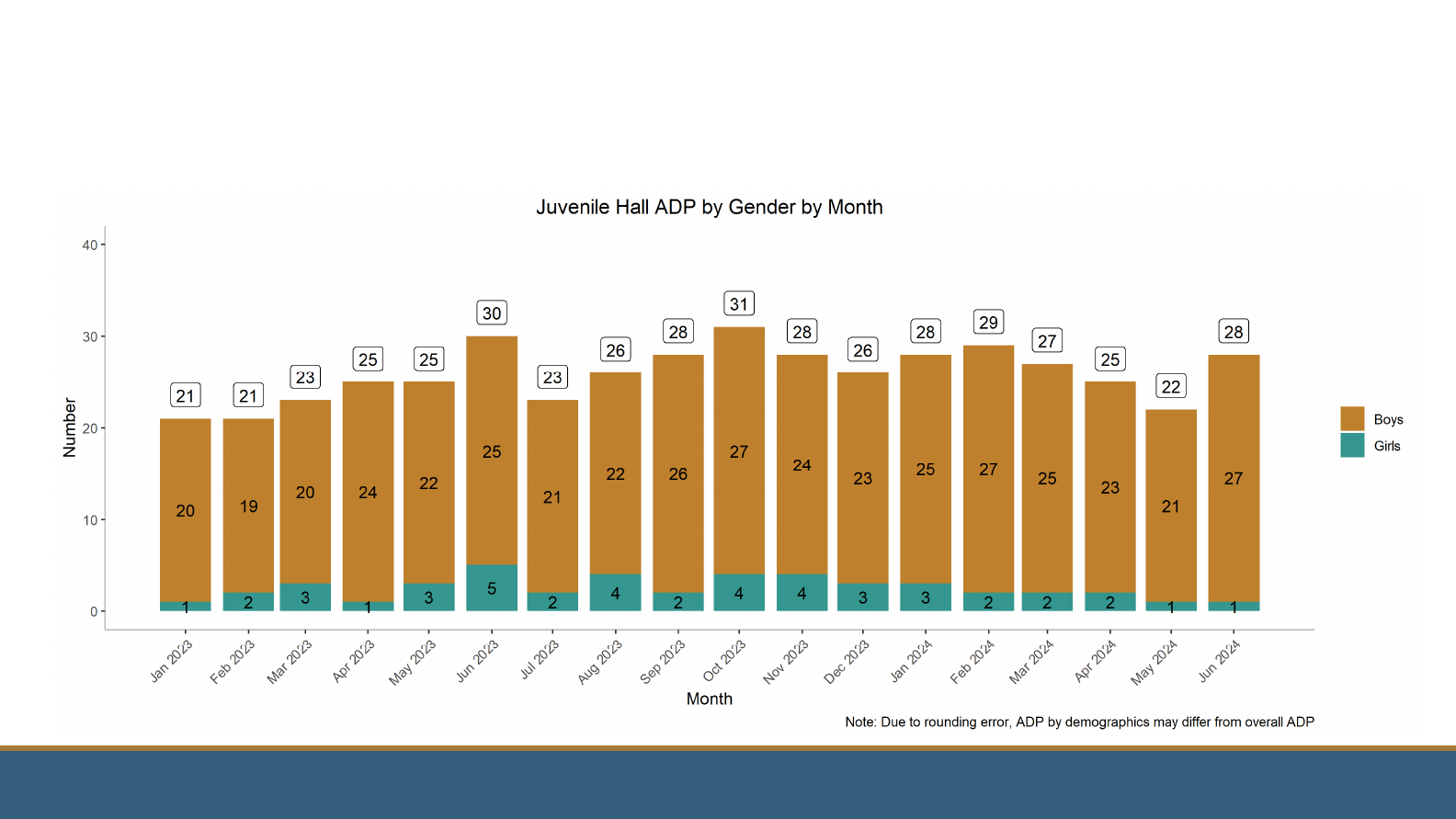
SanFranciscoJuvenileProbationDepartment
JH2.1:ADPbyGender
9

SanFranciscoJuvenileProbationDepartment
JH2.2:ADPbyRace/Ethnicity
10

SanFranciscoJuvenileProbationDepartment
JH2.3:ADPbyAge
11

SanFranciscoJuvenileProbationDepartment
JH2.4:ADPbyStatus
12

SanFranciscoJuvenileProbationDepartment
JHCharts3.1&3.2:AverageLengthofStay
• Description
• Charts 3.1 & 3.2 present the mean and median length of stay (ALOS) for: (3.1) detained youth
released each month and (3.2) detained and committed youth in custody on the last day of the
month.
• Due to small numbers, average length of stay for committed youth released will be
reported on in annual reports.
• In June,
• For detained youth released from Juvenile Hall throughout the month, the mean LOS was 11
days and the median LOS was 7 days.
• For detained youth in custody on the last day of the month, the mean LOS was 39 days and the
median LOS was 17 days.
• For committed youth in custody on the last day of the month, the mean LOS was 736 days and
the median LOS was 597 days.
13
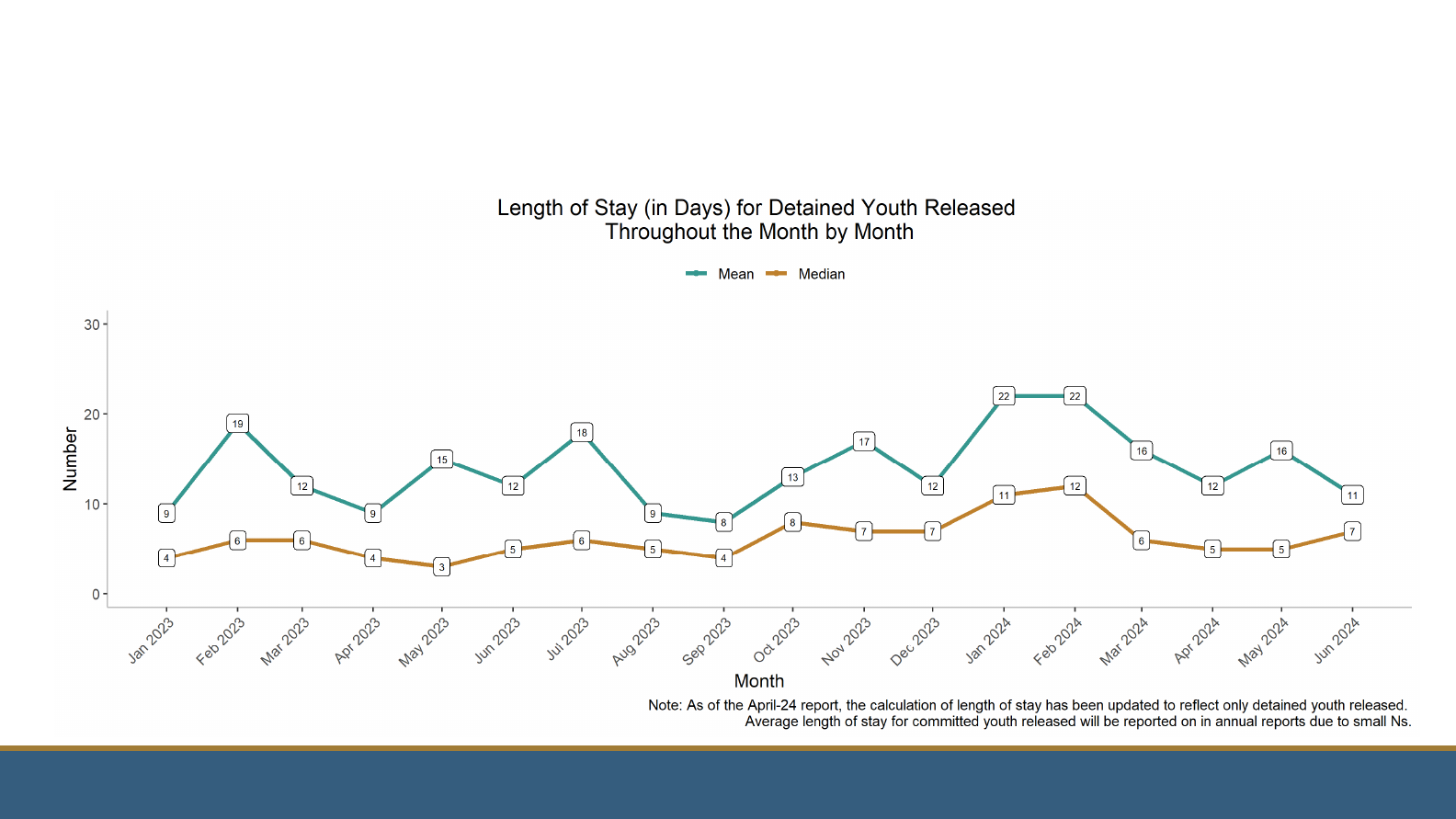
SanFranciscoJuvenileProbationDepartment
JH3.1:AverageLengthofStayforDetainedYouth
Released
14
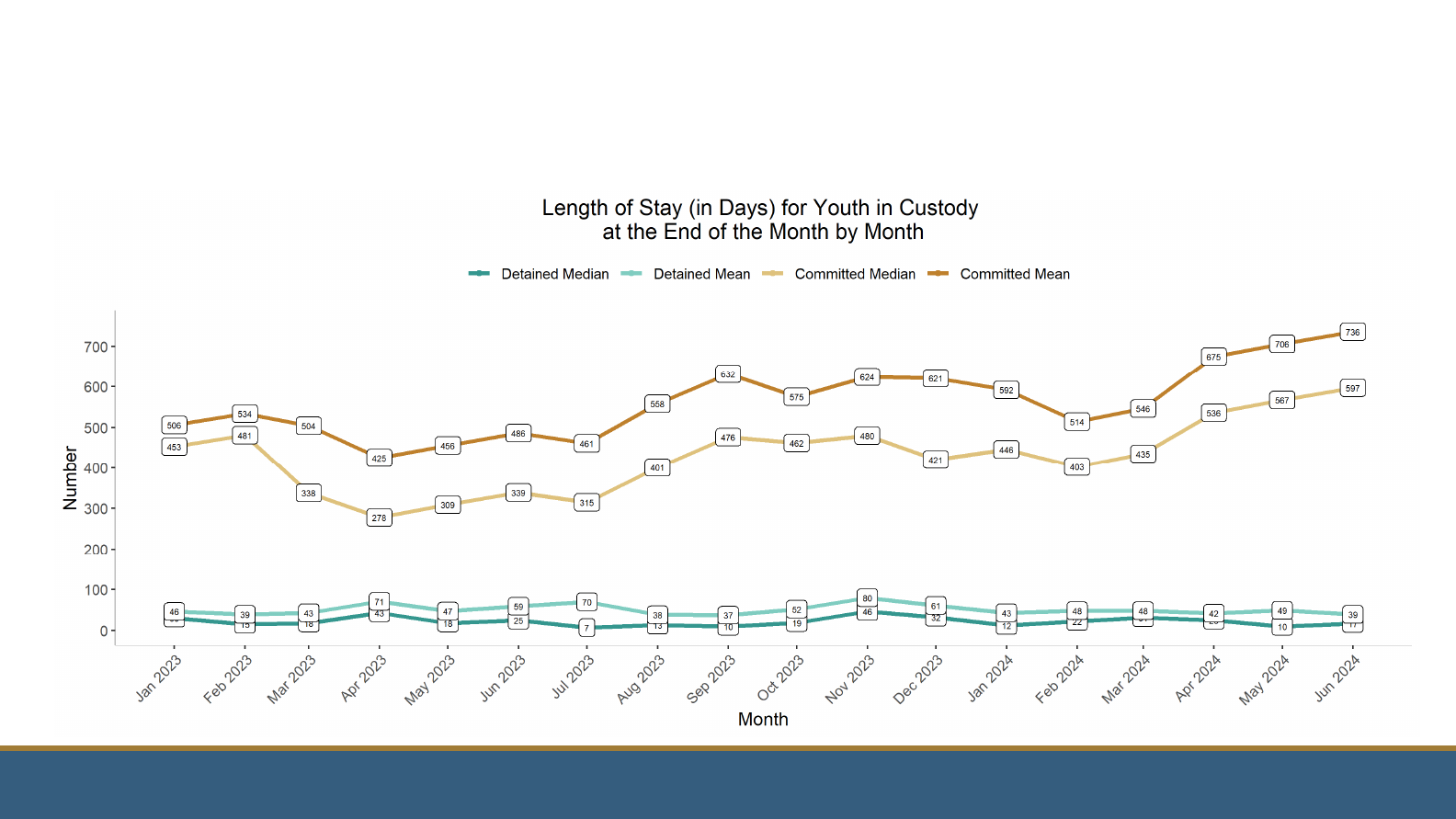
SanFranciscoJuvenileProbationDepartment
JH3.2:AverageLengthofStayforYouthinCustody
15

SanFranciscoJuvenileProbationDepartment
JHChart4.1&4.2:AdmissionsbyDetails
• Description
• Chart 4.1 displays Juvenile Hall admissions by the percentage that were mandated by state law. Chart 4.2
displays admissions by primary detention reason.
• Law mandates that youth brought into custody for the following must be detained until they can appear
before a judge:
• Youth at least 14 years old, arrested for personal use of a firearm in the attempt or commission of a
felony; or any offense listed in Welfare and Institutions Code section 707(b).
• Youth brought into custody pursuant to a court order, bench warrant, or arrest warrant.
• Youth transferred in custody from another jurisdiction.
• Non-mandatory detentions include felony firearm offenses, other jurisdiction holds, situations where there
are no non-secure options available to release a young person to, or a detention with supervisor approval.
• In June, there were 38 admissions to Juvenile Hall.
• 68% were mandatory: 15 new law violations and 11 warrants/court orders
• 32% were non-mandatory: 9 felony firearm offenses and 3 due to no non-secure option available
16

SanFranciscoJuvenileProbationDepartment
JH4.1:Admissionsby%Mandatory
17

SanFranciscoJuvenileProbationDepartment
JH4.2:AdmissionsbyPrimaryReason
18

SanFranciscoJuvenileProbationDepartment
JHChart5:JuvenileHallSnapshotbyStatus
• Description
• Chart 5 provides a snapshot of youth in Juvenile Hall on the Monday before Commission meetings (as
represented in Slide 3) by case status.
• Pre-adjudicated/Pre-disposition represents detained youth. Additional categories reflect youth who have
been committed to out-of-home placement and are awaiting placement, committed to Juvenile Hall, and
committed to Secure Track
• On the Monday before the June Commission meeting,
• 48% of youth in custody were committed to either Juvenile Hall or Secure Track and 14% were awaiting
placement.
19
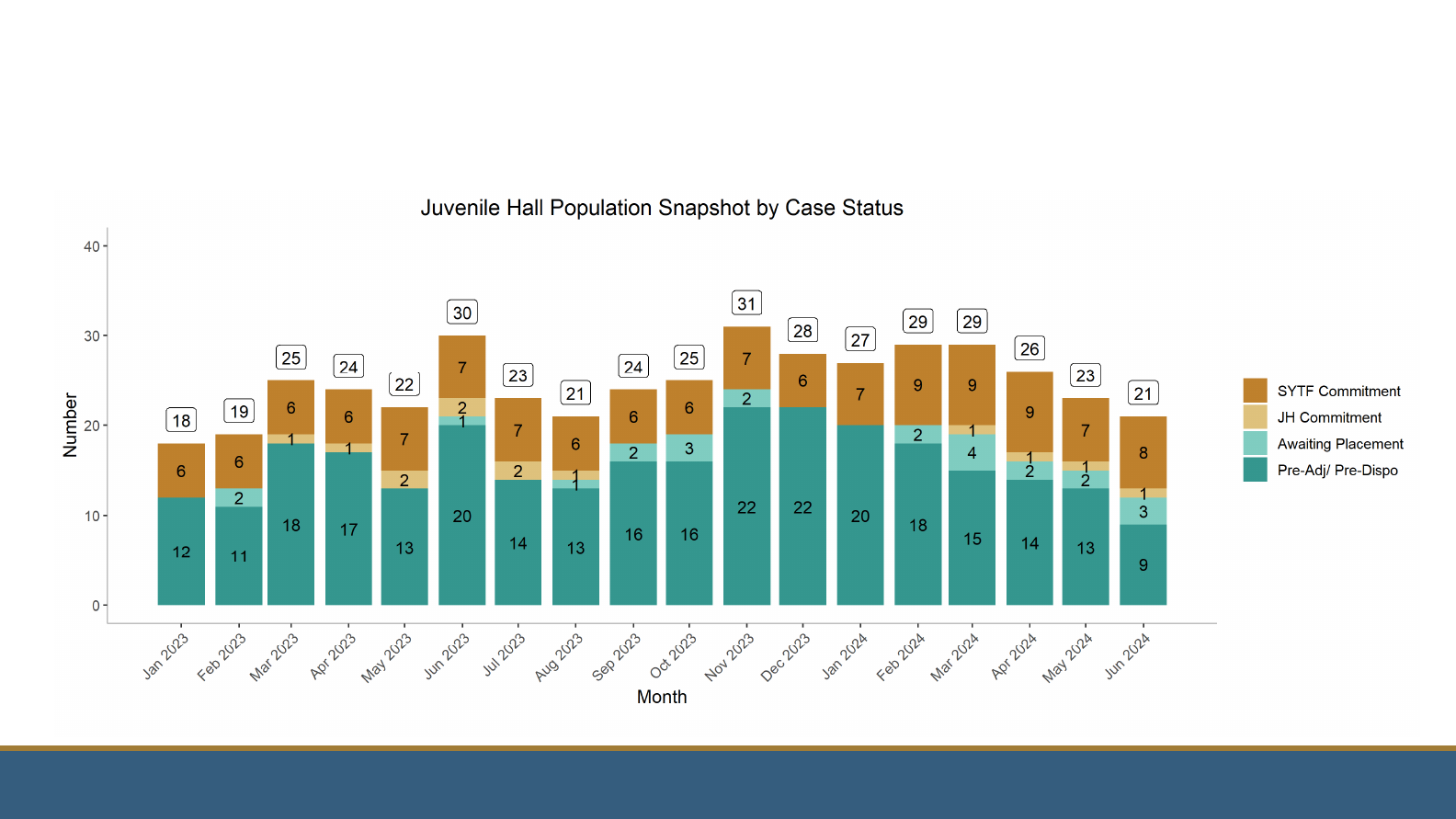
SanFranciscoJuvenileProbationDepartment
JHChart5:JuvenileHallSnapshotbyStatus
20

SanFranciscoJuvenileProbationDepartment
PSChart1:ReferralstoProbation&DivertedReferrals
• Description
• PS 1 provides statistics about the number of referrals to Probation and the number of diversion referrals each month. As of
January 2024, diversion measurement now reflects referrals to diversion programs rather than intakes.
• Some referrals are not diverted because they are counseled/referred & closed. Those are reflected on this chart.
• Diversion referrals include CARC Diversion, JPD/SFDA 654 Diversion, and SFDA Pre-Filing Diversion. Diversion
definitions and eligibility criteria can be found on the following slide.
• Counseled/referred & closed referrals and diverted referrals are included in the total number of Probation referrals.
• In June,
• There were 75 referrals to Probation:
• 41 were for felonies (56%), 18 of which were for 707(b) offenses (24%)
• 20 were for misdemeanors (26%), 14 of which originated in another county
• 14 were for warrants/probation violations (19%)
• 1 referral was counseled/referred & closed & 5 were diverted to CARC.
21
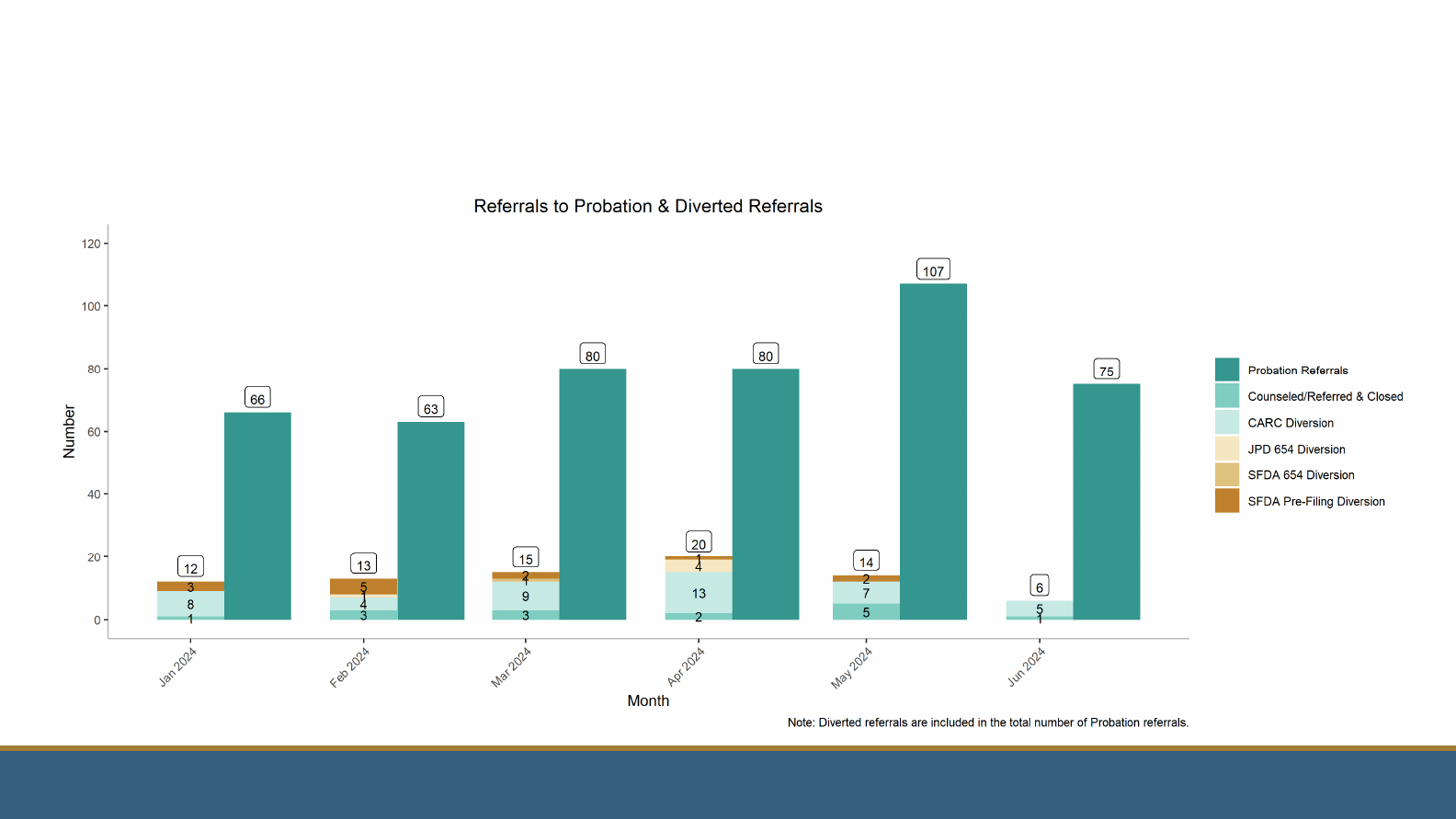
SanFranciscoJuvenileProbationDepartment
PS1:ReferralstoProbation&DivertedReferrals
22

SanFranciscoJuvenileProbationDepartment
DiversionGlossary
• Diversion is an alternative to the normal juvenile justice system. There are diversion opportunities at every stage of the juvenile justice process.
Probation may divert a young person rather than investigating the case. The District Attorney may divert a case rather than filing a petition. The Court
may divert a case rather than adjudicating the case. If a young person's case is diverted, they will have the opportunity to complete a program. If
successful, the young person may avoid going to court, or getting a petition or a disposition.
DefinitionDiversion
JPD counsels the youth and their caregiver, takes no further action on the case, and the case is closed. This is
distinct from diversion because there is no expectation to meet in order to close the case. Only certain cases
referred to JPD are eligible to be counseled and closed. This can include misdemeanors cases for out-of-county
youth, which are referred to the youth's home county.
Counseled/Referred & Closed
Youth is diverted to CARC at arrest. The young person does not complete an intake with JPD. If the young person
completes their CARC case plan, the case is not referred to the DA for prosecution. Most misdemeanors are eligible
to be diverted to CARC at point of arrest, with the exclusion of traffic referrals, out of county transfer-in citations, and
707(b) offenses. Cases that are not eligible for diversion, including felony citations, may also be referred to CARC
for support and services during the court process.
CARC Diversion
Youth is cited to JPD at arrest and is diverted by JPD either back to CARC or to another program pursuant to
Welfare & Institutions Code 654. If the young person completes their case plan, the case is not referred to the DA
for prosecution.
JPD 654 Diversion
Youth is cited to JPD at arrest and the case requires a referral to the DA pursuant to Welfare & Institutions Code
653.5(c). The DA instructs JPD to divert pursuant to Welfare & Institutions Code 654. If the young person completes
their case plan, the case is not prosecuted.
SFDA 654 Diversion
Youth is cited to JPD at arrest and the case requires a referral to the DA pursuant to Welfare & Institutions Code
653.5(c). The DA diverts the case to Make it Right, UCAP, or AFTER prior to filing charges. If the young person
completes their case plan, the case is not prosecuted.
SFDA Pre-Filing Diversion
23

SanFranciscoJuvenileProbationDepartment
PSChart2.1:ProbationActiveCaseload
• Description
• Chart 2.1 provides the total number of active cases on JPD's caseload for all units, both pre-
and post-adjudication, as well as AB12, as of the last day of the month.
• On the last day of June,
• The JPD active caseload was 389 youth.
• There were 238 pre-adjudicated cases (38% were diversion cases), 120 post-adjudicated
cases, and 31 AB12 cases.
24

SanFranciscoJuvenileProbationDepartment
PS2.1:ProbationActiveCaseload
25

SanFranciscoJuvenileProbationDepartment
PSCharts2.2&2.3:ActiveCaseloadbyUnit& Average
CaseloadSize
• Description
• Chart 2.2 shows active caseload by Unit by month, reflecting the most recent Unit
restructurings.
• Chart 2.3 shows the average caseload size per case manager by unit.
• Note: This includes all JPD staff that carry a caseload, including CARC, as well as JPD's
AB12 social workers.
• On the last day of June,
• The average caseload size per case manager was 18 youth.
• PS1 had the highest average caseload sizes at 22 youth, while CARC & AB12 had the lowest
at 10 youth.
26

SanFranciscoJuvenileProbationDepartment
PS2.2:ActiveCaseloadbyUnit
27

SanFranciscoJuvenileProbationDepartment
PS2.3:AverageCaseloadSize
28

SanFranciscoJuvenileProbationDepartment
PS2.4&2.5:ActiveCaseloadDemographics
• Description
• The next two slides show active caseload demographics (race/ethnicity, gender, age),
residential zip codes, and age as of the last day of the month. 2.4 shows the age breakdown for
the active caseload, by Unit.
• As of the last day of June,
• Girls represented 25% of the active caseload, and boys represented 75%.
• 50% of the active caseload was Black, 37% was Latinx, 7% was AAPI, 4% was white, and 3%
was other/unknown race/ethnicity.
• 30% of youth supervised by JPD live outside of San Francisco, and 38% of youth live in five zip
codes, with the largest group (15%) living in Bayview/Hunter's Point (94124).
• 30% of JPD's active caseload is 18 or older, with AB12 and Placement/JCRU supervising a
larger percentage of young adults than other units.
29

SanFranciscoJuvenileProbationDepartment
PS2.4:ActiveCaseloadDemographics
% of
Youth
# of
Youth
Neighborhood
30118Out of County
1560Bayview/Hunters Point (94124)
625Visitacion Valley/Sunnydale (94134)
623Mission/Bernal Heights (94110)
520Western Addition (94115)
519Ingleside/Excelsior (94112)
30

SanFranciscoJuvenileProbationDepartment
PS2.5:ActiveCaseloadDemographics
31

SanFranciscoJuvenileProbationDepartment
PSChart3:ActiveCaseloadActiveinPr ograms
• Description
• Chart 3.1 depicts the percentage of JPD's active caseload that is active in programs by month.
• Chart 3.2 is a new slide that shows the total number of youth referred to various Huckleberry
Youth programs (regardless of diversion status) per month.
• As of the last day of June, 75% of young people on active caseload were active in programs,
either in the community or in Juvenile Hall
• Notes: (1) Youth who are only on electronic or alcohol monitoring are not included in this
calculation.
• In June, 20 youth total were referred to Huckleberry Youth Programs.
32

SanFranciscoJuvenileProbationDepartment
PS3.1:ActiveCaseloadActiveinPrograms
33

SanFranciscoJuvenileProbationDepartment
PS3.2:HuckleberryServiceReferrals
34

SanFranciscoJuvenileProbationDepartment
PSCharts4.1&4.2:AlternativePlacement
• Description
• Chart 4.1 shows all youth in alternative placements by Gender, as of the last day of each month
for all status categories (see Alternative Placement Glossary):
• Table 4.2 provides details for each alternative placement category, as of the last day of each
month. A glossary is provided on the following slides.
• As of the last day of June,
• The total alternative placement population was 48 youth.
• Since the beginning of 2024, RFA + AFS placements have accounted for an average of 33% of
alternative placements per month, STRTPs have accounted for 6%, and commitments have
accounted for 21%.
35

SanFranciscoJuvenileProbationDepartment
PS4.1:AlternativePlacementsbyGender
36

SanFranciscoJuvenileProbationDepartment
PS4.2:AlternativePlacementsbyDetails
Avg %Jun-24May-24Apr-24Mar-24Feb-24Jan-24Alternative Placements
0%000001Pending Adjudication
2%001103Pending Disposition
7%453141Pending Placement
27%12131213119RFA
6%333222AFS
6%332134STRTP
3%111221Home Trial (Re-Entry)
3%222200THP+FC
2%111110Juvenile Hall Commitment
19%888898Secure Youth Treatment Facility
1%000011County Jail (adult criminal complaint)
3%1112
11SYTF Post-Release
7%443233Prop 57 Resentencing
13%866544AWOL
100%484743404138Total
37

SanFranciscoJuvenileProbationDepartment
AlternativePlacementGlossary
DefinitionStatus
When a youth previously ordered to out of home placement who has a petition filed and is moving through the court process however, the
petition has yet to be found true or dismissed.
Pending Adjudication
When a youth who has sustained charges and is now awaiting disposition or the court to make a determination on the outcome of the case.Pending Disposition
When a youth who has been committed to out of home placement by the court but is waiting for interviews, notice of acceptance, and the
scheduling of transportation is pending placement.
Pending Placement
A Resource Family (RFA) is a caregiver who provides out-of-home care for children in foster care.RFA
Alternative Family Services (AFS) placements are Intensive Services Foster Care (ISFC) Resource Family homes in the Bay Area, contracted
to serve youth involved in San Francisco's juvenile justice system.
AFS
Short-term Residential Therapeutic Program (STRTP), formerly referred to as a Group Home, is a residential facility operated by a public
agency or private organization that provides an integrated program of specialized and intensive care and supervision, services and supports,
treatment, and short-term 24-hour care and supervision to children and nonminor dependents.
STRTP
Home Trial is the period a youth is provided by the Court upon returning from an STRTP.Home Trial (Re-Entry)
Transitional Housing Placement-Plus Foster Care (THP+FC), also referred to as AB 12, allows eligible foster youth to extend foster care
beyond age 18 and up to age 21. The eligible foster youth are designated Non-Minor Dependents (NMDs) and are entitled to variousfoster
placement options including Supervised Independent Living Settings (SILPs).
THP + FC
When the Court orders a youth to remain in Juvenile Hall as their Disposition.Juvenile Hall Commitment
Due to the closure of DJJ, youth who would have previously been eligible to be committed to DJJ are now eligible to be committed to a
Secure Youth Treatment Facility (SYTF). Currently, San Francisco is using Juvenile Hall as its SYTF.
Secure Track Commitment
When a young adult (18+) has an outstanding juvenile warrant and is in county jail due to adult charges.
County Jail (adult criminal
complaint)
When a young person serving a Secure Youth Treatment Facility (SYTF) commitment has been released from custody is under community
supervision.
SYTF Post-Release
When an individual whose case was transferred to adult court as a juvenile has been re-sentenced and released under Proposition 57.Prop 57 Resentencing
When a youth leaves their court ordered placement or home without approval or consent of the program or parent/guardian/caregiver.AWOL
38

SanFranciscoJuvenileProbationDepartment
PSCharts5.1&5.2:ActiveWarrants
• Description
• Chart 5.1 is a new chart that shows the number and type of warrants active as of the last day of
each month.
• Arrest warrants are initiated by JPD, petition warrants are initiated by the police, and bench
warrants are initiated by the court.
• Chart 5.2 is a new chart that shows the mean and median age of warrants active as of the last
day of each month.
• As of the last day of June,
• There were 42 youth with active warrants and 53 active warrants total: 13 arrest warrants, 11
petition warrants, and 28 bench warrants.
• The mean length of time from warrant issue date was 252 days and the median was 200 days.
39

SanFranciscoJuvenileProbationDepartment
PS5.1:ActiveWarrantsbyType
40

SanFranciscoJuvenileProbationDepartment
PS5.2:ActiveWarrantsbyAgeofWarrant
41

SanFranciscoJuvenileProbationDepartment
PSChart6:ElectronicMonitoring
• Description
• Chart 6 provides data about the number of youth on electronic monitoring as of the last day of
each month and the average length of monitoring.
• As of the last day of June,
• There were 37 youth on electronic monitoring, with an average length of monitoring of 39 days.
• 19% were girls and 81% were boys
• 49% were Black, 41% were Latinx, and 11% were another race/ethnicity.
• There was 1 youth on alcohol monitoring.
42

SanFranciscoJuvenileProbationDepartment
PS6:ElectronicMonitoring
43

SanFranciscoJuvenileProbationDepartment
PSChart7:HomeDetention
• Description
• Chart 7 provides data for the number of youth on Home Detention as of the last day of the
month.
• Chart 7 also shows the average length of Home Detention on the last day of the month.
• As of the last day of June,
• There were 49 youth on Home Detention. The average length of stay was 75 days.
• 18% were girls & 82% were boys
• 41% were Black, 35% were Latinx, 24% were another race or ethnicity
• 88% were pre-adjudicated
44

SanFranciscoJuvenileProbationDepartment
PS7:HomeDetention
45

SanFranciscoJuvenileProbationDepartment
PSChart8:PetitionDispositions
• Description
• Chart 8 shows all petition dispositions by month.
• Since the start of 2024,
• 3% resulted in commitments to SYTF or Juvenile Hall
• 11% resulted in out of home placement (commit + recommit to out of home placement)
• 19% of dispositions resulted in wardship probation (ward probation + wardship redeclared).
• 5% resulted in 725(a) non wardship probation
• 26% resulted in 654 informal probation
• 20% resulted in transfers out
• 15% resulted in dismissals
46

SanFranciscoJuvenileProbationDepartment
PS8:PetitionDispositions
47

THANK YOU
QUESTIONS?
